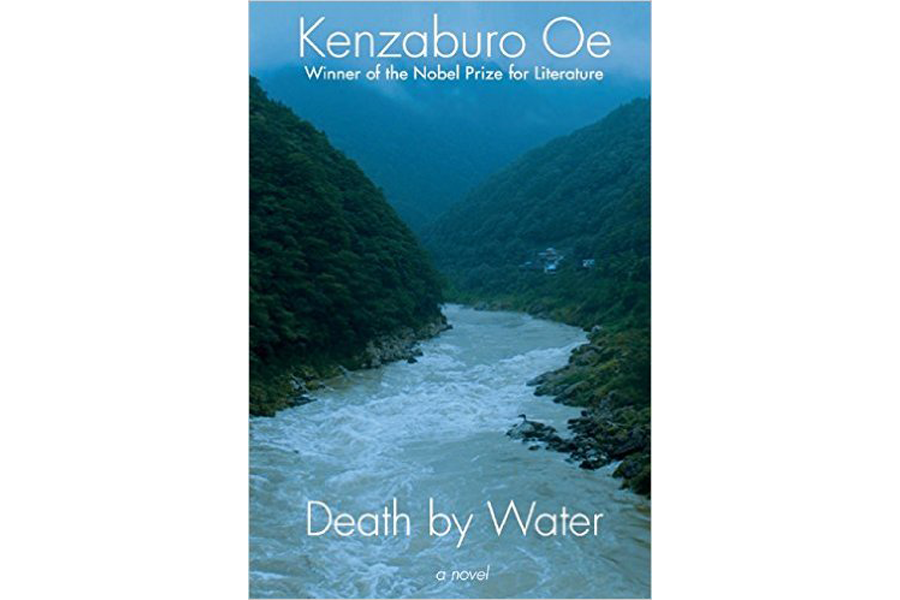'Death by Water' takes readers on a wild ride of epic proportions
Loading...
In addition to being noted for his prodigious literary accomplishments, 1994 Nobel Prize-winning Kenzaburō Ōe is known for being politically outspoken. He made international headlines again during this year’s 70th anniversary of the Nagasaki/Hiroshima bombings. His esteemed name and reputation alone ought to inspire readers to seek out his latest-title-in-translation, Death by Water, which lands in the US six years after its initial Japanese publication.
And so they should. My advice to you: Buy, borrow, or steal this book – and then set aside some substantial reading time. This could be the densest and most rewarding 432 pages you’ll experience this year.
For first-time Ōe-readers, “Death by Water” is an intriguing mystery-of-sorts that easily stands alone. An octogenarian writer, Kogito Choko, is finally given access to the contents of a red leather trunk, which he believes will reveal the circumstances under which his father drowned in a small boat during a summer storm just before the end of World War II. As requested, his younger sister Asa held on to the trunk until the 10th anniversary of their mother’s death. Choko is certain the trunk holds answers that will allow him to finish his “drowning novel ... a definitive novel about [his] father” that he began almost half a century ago. He returns to his childhood home in Shikoku from Tokyo, expecting – at the very least – some sense of closure.
With Asa’s introduction and encouragement, Choko agrees to share the process of discovery and completion with a theater troupe whose founding director has been successfully staging Choko’s body of work. The hoped-for collaboration ends abruptly when Choko learns that the trunk’s contents are less than illuminating and he abandons his novel to return to Tokyo. Extenuating family circumstances send him back to Shikoku, this time with his eldest son. By previous agreement, two women from the theater group have moved into the family home, and the drama – enlightening, convoluted, surreal – continues.
For Ōe aficionados, get ready for a wild ride of epic proportions: dig deep into your thinking caps, line up your other Ōe titles, pull up your search engines, because you’ve got gratifying work to do. This is Ōe’s fifth novel in which Kogito Choko takes center stage; for decades, Choko has been Ōe’s literary alter ego with countless autobiographical overlaps. Shikoku origins, publishing history, prematurely lost father, brain-damaged son with musical genius – all that and more is shared by writer and protagonist here. Ghosts loom, not just on the page, but from Ōe’s real life – the late brother-in-law in this fiction was, in reality, Juzo Itami, director of the cult classic “Tampopo,” who also leaped to his suicide. (Ōe’s novel "The Changeling," published in Japanese in 2000 and in English in 2010, eerily explored the tragedy.) Deciphering what’s "real," and what’s not, in "Death by Water," creates a fascinating meta-narrative.
Woven into Ōe’s personal story – real and imagined – is Japan’s troubled history, from ultranationalism to Emperor-worship to heinous war crimes. A powerful government official uncle and his damaged niece become stand-ins for Japan’s use of sexual slavery during war, a practice vehemently denied decades later despite solid evidence to the contrary. Literary figures appear to enhance story and history both, from childhood reminiscences of “The Adventures of Huckleberry Finn” to “The Wonderful Adventures of Nils,” to the life and work of Natsume Sōseki (considered Japan’s greatest modern novelist), to personal exchanges with the late scholar Edward Said with whom Ōe shared a close friendship. Choko channels Said’s posthumously published final title, “On Late Style,” during an impromptu interview while Ōe pays further homage to Said with the title of his 2013 novel (his sixth featuring Choko, not yet published in English), “In Late Style.”
Presented as an absorbing, complex collage of multi-layered prose, poetic references, epistolary exchanges, memories, and dreams, “Death” demands attention and diligence. Ōe – always a bit of a self-referential comic – acknowledges the necessary languid pace by repeating certain pertinent details including names and relationships, albeit with slight variations in descriptions as if to remind us that nothing stays the same. His penchant for such mutable words as “transition,” “transformation,” “transmogrify” can’t be ignored.
If “Death” has faults, these lie outside Ōe’s purview: Translator Deborah Boliver Boehm seems to lack the fluidity of scholar/professor John Nathan who has rendered three previous Ōe novels into English. Clumsily inserted colloquialisms – “settled into my digs,” for example – seem incongruous with Ōe’s original intentions. As if all too aware, Choko comments about “which translators are better than others,” and that “for a bilingual reader it can also be interesting to take note of the striking discrepancies between the original and the Japanese translations, which occur more often than you might think.” Such misinterpretations and digressions notwithstanding, that “Death” is now accessible promises to be an essential revelation.
Terry Hong writes BookDragon, a book blog for the Smithsonian Asian Pacific American Center.








